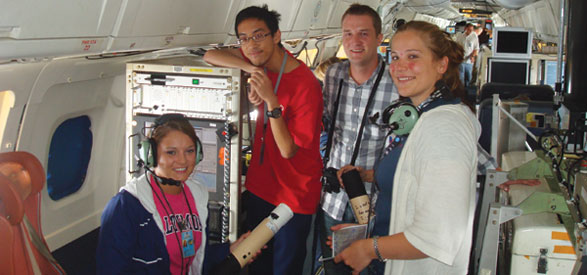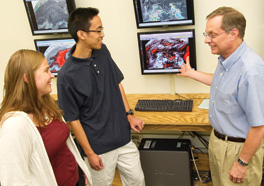
Into the Eye of the Storm
By Greta Petry, M.A.’01
To find clues that will help scientists provide more advance warning of hurricanes, several UAlbany faculty and students literally flew into the eye of the storm last semester.
Graduate students Diana Thomas of Lillington, N.C., and Leon Nguyen of Fresno, Calif., boarded a NASA DC-8 with Research Professor of Atmospheric and Environmental Sciences John Molinari as part of a field study to determine what transforms some weather events, but not others, into tropical storms and hurricanes.
Based in Fort Lauderdale, Fla., Molinari and his atmospheric science students were part of the NASA-supported experiment Genesis and Rapid Intensification Processes (GRIP), which focused on how hurricanes form and why they often intensify rapidly. Professor and Chair Christopher Thorncroft was involved with GRIP, as well; his doctoral student, Matt Janiga of Chicago, Ill., joined Thomas and Nguyen in Fort Lauderdale. All were part of a three-pronged research effort that also dispatched research scientists to St. Croix and California. Thomas, a second-year master’s student, has enjoyed the unpredictability of weather ever since she was a girl observing approaching thunderstorms with her dad, Neill.
“Each day is different,” said Thomas. “No two storms are exactly alike, and the excitement of watching a storm develop has stayed with me.” Another group, led by Distinguished Professor Lance Bosart, was based in St. Croix, U.S. Virgin Islands, from Aug. 15 to Sept. 30 as part of Pre-Depression Investigation of Cloud-systems in the Tropics (PREDICT). Since storms often form in the vicinity of St. Croix, flights extending thousands of miles from there were conducted. Doctoral candidates Heather Archambault and Jason Cordeira; Thomas Galarneau, Ph.D.’10; and Kyle Griffin, who arrived on campus as a new doctoral student last fall, helped forecast for PREDICT aircraft operations and analyze data collected during the experiment.
“The real scientific challenge was to understand why so few potential disturbance seedlings develop into tropical cyclones,” Bosart said. PREDICT’s goal was to fly research aircraft into disturbance seedlings (cloud clusters) to obtain measurements that would help scientists find answers to this puzzle.
"No two storms are exactly alike, and the excitement of watching a storm develop has stayed with me."
Assistant Professor Ryan Torn, who remained in Albany, incorporated data supplied by the aircraft into the computer model to help scientists understand what physical processes limit their ability to predict hurricane formation.
National Science Foundation and NASA funding for this experiment – in Albany alone – totaled more than $800,000 among Bosart, Torn, Thorncroft and Molinari.

Graduate students Diana Thomas and Leon Nguyen and Professor John Molinari, pictured from left, participated last semester in a field study focused on hurricane formation and intensification.
“Ultimately,” said Molinari, “this work will help us to understand and predict hurricane formation, which remains an unsolved scientific problem. Many times, all the ingredients – warm water; persistent, intense rainfall; and a pre-existing low-pressure area – are there, yet development does not occur, or is delayed for 24 to 48 hours. We want to understand what processes delay or even prevent tropical cyclone formation, as well as what brings it about.”
Molinari added: “Although we all have access to a huge volume of data collected in hurricanes, there is no substitute for actually being present when the data is collected. We got to see the eyewall and eye of the storms multiple times during our flights – a tremendous benefit when one is analyzing data. In GRIP, we flew into numerous storms, but my favorite was Hurricane Earl.”
The flights afforded the researchers an opportunity to observe the formation of Earl’s eyewall and the development of an eye, and to capture the latter with multiple instruments. “It will take additional months to assemble, process and interpret the data. Our goal will be to understand what factors in the storm and in its environment are responsible for the formation of the eye and the eyewall in tropical cyclones,” explained Molinari.
“Rapid intensification,” a separate phase of hurricane development, transforms a tropical depression or a weak tropical storm into a hurricane. Because this phenomenon frequently occurs near coastal regions, often quickly and with little warning, it is especially important to understand. Unlocking the mystery of rapidly intensifying tropical cyclone formation may one day enable scientists to give more advance warning to hurricane-vulnerable communities. The National Oceanic and Atmospheric Administration (NOAA), running the Intensity Forecast Experiment (IFEX) and based at the Hurricane Research Division in Miami, Fla., was the third group involved in the research.
Seven aircraft – including NOAA aircraft flown out of Tampa, Fla., and NASA’s Global Hawk, a California-based unmanned aircraft that can remain aloft for 36 hours – supported the research projects.
For the students, Molinari said, the project presented “a great opportunity not only in the air, but also on the ground. They observed how a field experiment is designed and carried out, and the challenges that are always present.”
- UAlbany Magazine
Spring 2011 - Cover Story
- Features
- Departments
- Archives
-
Download the PDF
Spring 2011 issue
(includes the Carillon)




